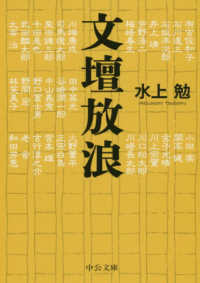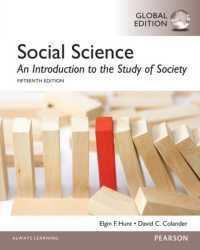Full Description
When we think of family, we most often think of our sisters and brothers, our cousins and grandparents, rather than our world family or even our community connections. We still identify with our differences more than our similarities, unless it's convenient to do otherwise. Here, two seasoned authors tackle the question of family and what it means to us now and how it might change to help us address the problems that affect us all. Using specific examples throughout the work, they present a unique approach to what it means to belong to one human family. Beginning with a consideration of how the family unit has begun to be defined by allegiances, by common ties and empathy, the authors then discuss the evolution of the family unit and how the 'us' vs. 'them' mentality gave way to a way of life that separated peoples rather than brought them together. They consider family values, how they arose, developed, were perverted or perfected to suit the family unit's needs, and the confusion that followed. Humanity on a Tightrope focuses on what families and family values are, and how they often create an 'us versus them' mentality that is at the root of many of today's most crucial problems from terrorism, racism, and war to the failure of humanity to come to grips with potentially lethal global environmental problems. The book underlines a basic element for solving the human predicament — quickly spreading the domain of empathy. It takes a close look at how we can do that, building on the findings of both social and natural science and using tools ranging from brain imaging to the internet. It explains how civilization is unlikely to persist unless many more people learn to put themselves in the shoes of others to keep society balancing on the tightrope to sustainability - a tightrope suspended over the collapse of civilization.
Contents
1 Section 1 Connecting with others: The Evolution of Humanity, Families and Empathy 2 Chapter 1 On a Tightrope 3 Chapter 2 Empathy, And "Us" Family Members versus "Them" 4 Chapter 3 The Seeds Of Family Values And How They Sprouted 5 Chapter 4 The Evolution of "Them" 6 Section 2 Changing Our Mind and Changing the World we Made 7 Chapter 5 The Neuropsychology Of Getting To "Us": The More Alike The More We Like 8 Chapter 6 It's All Us Now: Closing the Culture Gap and Building a Global Family 9 Chapter 7: The Beginnings of a New Stage in History 10 Chapter 8 Getting To "Alike" One Another 11 Chapter 9 Revitalizing Religious Empathy and Staying on the Tightrope 12 Appendix Going Further: Reading, Informing, Acting 13 Bibliography 14 Acknowledgments








